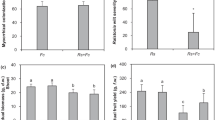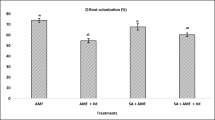Abstract
Verticillium dahliae alters water status and consequently, growth and production of pepper plants. On the other hand, arbuscular mycorrhizal fungi (AMF) can reduce damage caused by specific soil-borne plant pathogens and improve drought resistance of pepper. Therefore, one objective of this research was to assess if AMF can modify the development of Verticillium-wilt in pepper plants. A second objective was to study the influence of plant phenology at the moment when V. dahliae was inoculated on the possible biocontrol of the disease by AMF. Results suggested that AMF reduce the deleterious effect of V. dahliae on pepper growth and yield. However, bioprotection against Verticillium-wilt was conditioned by plant phenology at the moment of pathogen attack. The highest efficacy of AMF occurred when V. dahliae was inoculated during the vegetative stage of plants. AMF allowed leaf relative water content to be maintained for longer and delayed both the appearance of disease symptoms and the decrease of photosynthesis in Verticillium-inoculated plants. These benefits on plant physiology increased pepper yield.
Similar content being viewed by others
References
Agustí M (2000) Crecimiento y maduración del fruto. In: Azcón-Bieto J and Talón M (eds) Fundamentos de Fisiología Vegetal (pp 419-433) Edicions Universitat de Barcelona and McGraw-Hill Interamericana, Madrid
Augé RM (2001) Water relations, drought and vesiculararbuscular mycorrhizal symbiosis. Mycorrhiza 11: 3–42
Azcón-Aguilar C, Jaizme-Vega MC and Calvet C (2002) The contribution of arbuscular mycorrhizal fungi for bioremediation. In: Gianinazzi S, Schüepp H, Barea JM and Haselwandter K (eds) Mycorrhizal Technology in Agriculture. From Genes to Bioproducts (pp 187-197) Birkhäuser Verlag, Basel
Bethlenfalvay GJ, Brown MS and Pacovsky RS (1982) Parasitic and mutualistic associations between a mycorrhizal fungus and soybean: Development of the host plant. Phytopathology 72: 889–893
Borowicz VA (2001) Do arbuscular mycorrhizal fungi alter plant-pathogen relations? Ecology 82: 3057–3068
Bowden RL and Rouse DI (1991) Effects of Verticillium dahliae on gas exchange of potato. Phytopathology 81: 293–301
Danneberg G, Latus C, Zimmer W, Hundeshagen B, Schneider-Poetsch HJ and Bothe H (1992) Influence of vesicular-arbuscular mycorrhiza on phytohormone balances in maize (Zea mays L.). Journal of Plant Physiology 141: 33–39
Davies FT, Potter JR and Linderman RG (1993) Drought resistance of mycorrhizal pepper plants independent of leaf P concentration-response in gas exchange and water relations. Physiologia Plantarum 87: 45–53
García-Mina JM, Jordana R, Aguirreolea J and Hernández MA (1996) The effect of a special organic amendment on the development of pepper plants cultivated in a soil infested with Verticillium dahliae. In: Rodríguez-Barrueco C (ed) Fertilizers and Environment (pp 301-303) Kluwer Academic Publishers, the Netherlands
Goicoechea N, Antolín MC, Strnad M and Sánchez-Díaz M (1996) Root cytokinins, acid phosphatase and nodule activity in drought-stressed mycorrhizal or nitrogen fixing alfalfa plants. Journal of Experimental Botany 47: 683–686
Goicoechea N, Antolín MC and Sánchez-Díaz M (1997) Gas exchange is related to the hormone balance in mycorrhizal or nitrogen-fixing alfalfa subjected to drought. Physiologia Plantarum 100: 989–997
Goicoechea N, Aguirreolea J, Cenoz S and García-Mina JM (2000) Verticillium dahliae modifies the concentrations of proline, soluble sugars, starch, soluble protein and abscisic acid in pepper plants. European Journal of Plant Pathology 106: 19–25
Goicoechea N, Aguirreolea J, Cenoz S and García-Mina JM (2001) Gas exchange and flowering in Verticillium-wilted plants. Journal of Phytopathology 149: 281–286
Hayman DS, Barea JM and Azcón R (1976) Vesicular-arbuscular mycorrhiza in southern Spain: Its distribution in crops growing in soil of different fertility. Phytopathology of the Mediterranean 15: 1–6
Hewitt EJ (1966) Sand and water culture methods used in the study of plant nutrition. In: Technical Communication No. 22, 2nd edn revised, Commonwealth Agricultural Bureaux, London
Ho LC (1992) Fruit growth and sink strength. In: Marshall C and Grace J (eds) Fruit and Seed Production. Aspects of Development, Environmental Physiology and Ecology (pp 101-124) Society for Experimental Biology, Seminar Series 47, University Press, Cambridge
Hoyos GP, Laurer FI and Anderson NA (1993) Early detection of Verticillium wilt resistance in a potato breeding program. American Potato Journal 70: 535–541
Jaizme-Vega MC, Tenouty P, Pinochet J and Jaumot M (1997) Interactions between the root-knot nematode Meloidogyne incognita and Glomus mosseae in banana. Plant and Soil 196: 27–35
Lorenzini G, Guidi L, Nali C, Ciompi S and Soldatini GF (1997) Photosynthetic response of tomato plants to vascular wilt diseases. Plant Science 124: 143–152
Mushin TM and Zwiazek JJ (2002) Ectomycorrhizas increase apoplastic water transport and root hydraulic conductivity in Ulmus americana seedlings. The New Phytologist 153: 153–158
Pegg GF (1989) Pathogenesis in vascular diseases of plants. In: Ayres PG (ed) Effects of Disease on the Physiology of the Growing Plant (pp 149-177) Cambridge University Press, Cambridge
Phillips JM and Hayman DS (1970) Improved procedures for clearing roots and staining parasitic and vesicular-arbuscular mycorrhizal fungi for rapid assessment of infection. Transactions of the British Mycological Society 55: 158–161
Sadras VO, Quiroz F, Echarte L, Escande A and Pereyra VR (2000) Effect of Verticillium dahliae on photosynthesis, leaf expansion and senescence of field-grown sunflower. Annals of Botany 86: 1007–1015
Scholander PF, Hammel HT, Badstreet ED and Hemmingsen EA (1965) Sap pressure in vascular plants. Science 148: 339–346
Singh R, Adholeya A and Mukerji KG (2000) Mycorrhiza in control of soil borne pathogens. In: Mukerji KG, Chamola BP and Singh J (eds) Mycorrhizal Biology (pp 173-196) Kluwer Academic Publishers, New York
Sokal RR and Rohlf FJ (1979) Biometría H. Blume, Madrid
Tzeng DD, Wakeman RJ and DeVay JE (1985) Relationships among Verticillium wilt development, leafwater potential, phenology, and lint yield in cotton. Physiological and Molecular Plant Pathology 26: 73–81
Weatherley PE (1950) Studies in the water relations of the cotton plant. I. The field measurements of water deficits in leaves. The New Phytologist 49: 81–87
Author information
Authors and Affiliations
Corresponding author
Rights and permissions
About this article
Cite this article
Idoia, G., Nieves, G. & Jone, A. Plant Phenology Influences the Effect of Mycorrhizal Fungi on the Development of Verticillium-induced Wilt in Pepper. European Journal of Plant Pathology 110, 227–238 (2004). https://doi.org/10.1023/B:EJPP.0000019790.45397.90
Issue Date:
DOI: https://doi.org/10.1023/B:EJPP.0000019790.45397.90




